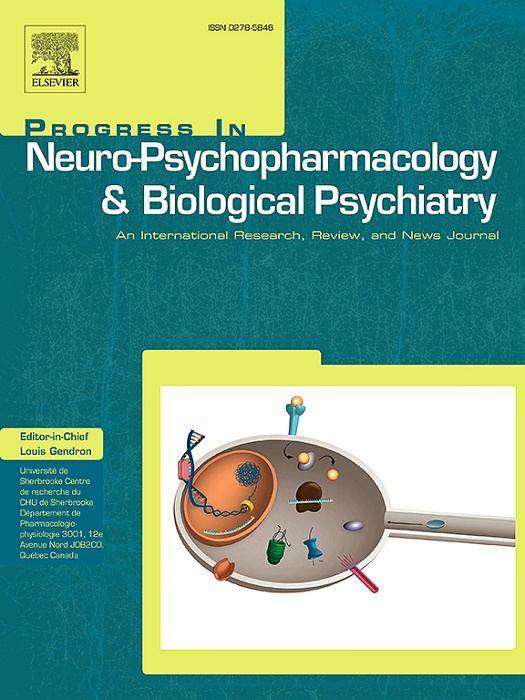A novel multidimensional, perinatal social and material deprivation paradigm induces aggressive behavior and cortical gene expression reprogramming in young adult mice
IF 3.9
2区 医学
Q1 CLINICAL NEUROLOGY
Progress in Neuro-Psychopharmacology & Biological Psychiatry
Pub Date : 2025-06-25
DOI:10.1016/j.pnpbp.2025.111432
引用次数: 0
Abstract
Poverty is a complex, multidimensional stressor that affects both physical and mental health outcomes. Current animal models often isolate single aspects of socioeconomic adversity, limiting their translational relevance. This study introduces a novel murine model of social and material deprivation (SMD) designed to simulate the co-occurrence of environmental impoverishment and social stress observed in real-world settings.
During gestation and lactation pregnant mice and their litters were exposed to a combination of reduced nesting/bedding material, lack of cage enrichment, maternal separation with early weaning, and threat from a dominant male. Behavioral tests, brain morphology assessments, and prefrontal cortex gene expression analyses were performed in the offspring, considering sex as a biological variable throughout.
SMD dams displayed increased depressive-like behavior and maladaptive coping strategies, along with reduced maternal care. Offspring exhibited delayed neurodevelopment, increased anxiety-like behavior and aggression in males, and structural brain alterations, including reduced dorsal (females) and ventral (both sexes) hippocampal area, and increased prefrontal cortex width in both sexes.
Transcriptomic analyses of the prefrontal cortex revealed sex-specific patterns: in males, genes involved in neuronal development and immune function were predominantly upregulated; in females, chromatin remodeling genes were upregulated, while immune-related genes were downregulated.
The SMD model recapitulates key behavioral, morphological, and molecular features associated with early-life adversity and socioeconomic disadvantage, offering a valuable tool to investigate sex-specific neurobiological responses to complex stress exposure during sensitive developmental windows.
一个新的多维,围产期社会和物质剥夺范式诱导攻击行为和皮层基因表达重编程的年轻成年小鼠。
贫穷是一个复杂的、多方面的压力源,影响身体和精神健康结果。目前的动物模型经常孤立社会经济逆境的单一方面,限制了它们的翻译相关性。本研究介绍了一种新的社会和物质剥夺(SMD)小鼠模型,旨在模拟在现实环境中观察到的环境贫困和社会压力的共同发生。在妊娠期和哺乳期,孕鼠及其幼崽暴露于筑巢/床上材料减少、笼子缺乏浓缩、母鼠早期断奶分离以及来自优势雄鼠的威胁。在考虑性别作为一个生物学变量的情况下,对后代进行了行为测试、脑形态评估和前额叶皮层基因表达分析。SMD坝表现出增加的抑郁样行为和适应不良的应对策略,以及减少的产妇护理。后代表现出神经发育延迟,雄性的焦虑样行为和攻击性增加,大脑结构改变,包括雌雄海马背侧和腹侧面积减少,以及雌雄的前额叶皮质宽度增加。前额叶皮层的转录组学分析揭示了性别特异性模式:在男性中,涉及神经元发育和免疫功能的基因主要上调;在女性中,染色质重塑基因上调,而免疫相关基因下调。SMD模型概括了与早期生活逆境和社会经济劣势相关的关键行为、形态和分子特征,为研究在敏感发育窗口期对复杂应激暴露的性别特异性神经生物学反应提供了有价值的工具。
本文章由计算机程序翻译,如有差异,请以英文原文为准。
求助全文
约1分钟内获得全文
求助全文
来源期刊
CiteScore
12.00
自引率
1.80%
发文量
153
审稿时长
56 days
期刊介绍:
Progress in Neuro-Psychopharmacology & Biological Psychiatry is an international and multidisciplinary journal which aims to ensure the rapid publication of authoritative reviews and research papers dealing with experimental and clinical aspects of neuro-psychopharmacology and biological psychiatry. Issues of the journal are regularly devoted wholly in or in part to a topical subject.
Progress in Neuro-Psychopharmacology & Biological Psychiatry does not publish work on the actions of biological extracts unless the pharmacological active molecular substrate and/or specific receptor binding properties of the extract compounds are elucidated.

 求助内容:
求助内容: 应助结果提醒方式:
应助结果提醒方式:


